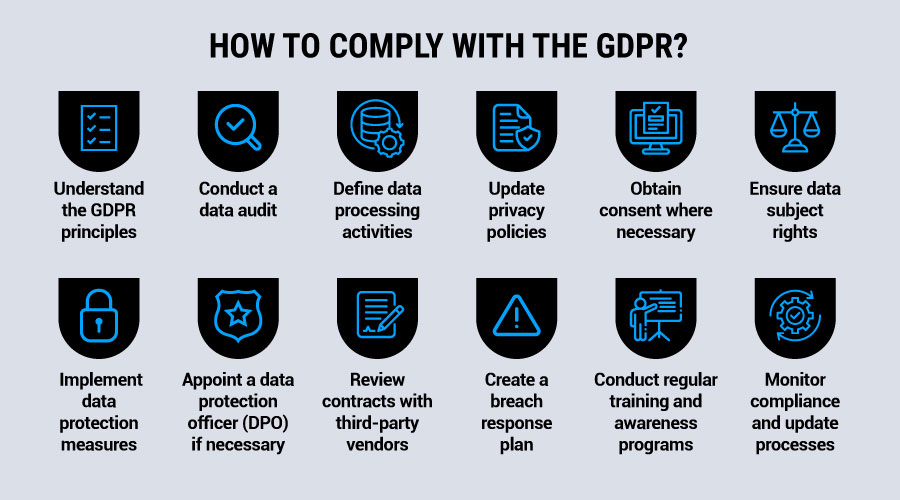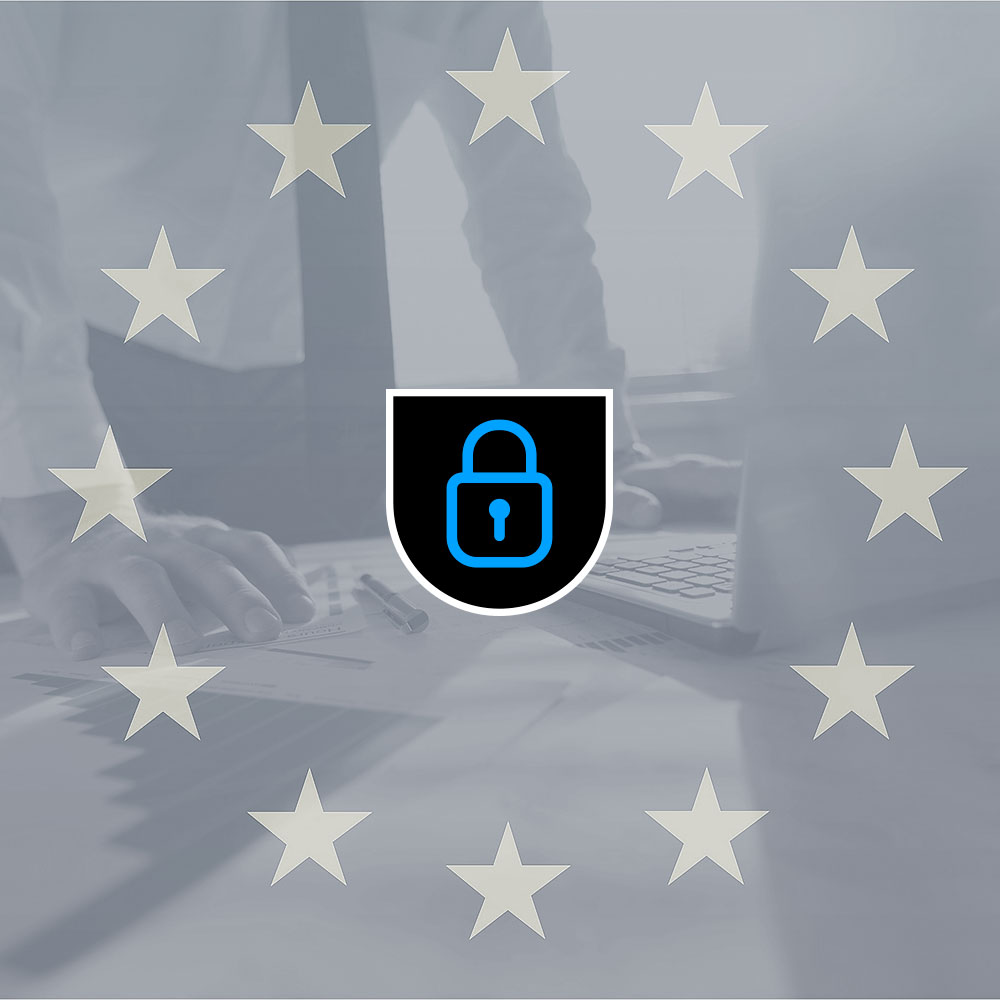The General Data Protection Regulation (GDPR) is one of the strictest privacy laws globally, and since it came into effect in 2018 it has reshaped how businesses handle personal data. It has also influenced subsequent data privacy legislation around the world.
But the GDPR is more than a legal requirement, it’s also an opportunity to demonstrate to customers that you prioritize their privacy.
Although GDPR compliance may seem complex, the long-term benefits it can bring to your business are worth it. It offers an opportunity to build trust and enhance data management practices.
Below is all the essential information you need to know about GDPR compliance. From its technical requirements to the key steps to take to achieve and maintain compliance.
What is the General Data Protection Regulation (GDPR)?
The General Data Protection Regulation (GDPR) is an EU law designed to protect individuals’ personal data and privacy. At its core, it gives people more control over how their information is collected, stored, and used. It also establishes strict requirements for companies regarding the collection and processing of personal data. And regulates organizations that handle personal data.
The GDPR replaced the Data Protection Directive in May 2018. Unlike a directive, which commonly requires individual countries to pass their own laws using the directive guidelines, the GDPR applies across all EU member states and the European Economic Area (EEA). This means that all organizations must comply with a single set of rules. Even though each member state handles its own enforcement, doing so is more consistent.
What is considered personal data under the GDPR?
Personal data under the GDPR includes any information that can identify an individual, either directly or indirectly. This includes:
- Names, addresses, and phone numbers
- Email addresses and online identifiers (e.g., IP addresses, cookie data)
- Financial data (e.g., credit card details, banking information)
- Health and biometric data
- Employment details
Sensitive personal data includes information like racial or ethnic origin, political opinions, religious beliefs, and genetic data. It has different and more stringent requirements, like greater protections, than other personal personal data because of the harm that could occur if it is shared.
What is GDPR compliance?
Compliance with the GDPR means following the regulation’s rules for handling personal data. Organizations must ensure transparency, security, and accountability in their data processing practices. This includes obtaining user consent when required, implementing security measures, and responding to requests from data subjects.
Achieving GDPR compliance involves an ongoing combination of legal, technical, and organizational measures.
Who needs to comply with the GDPR?
If you collect or process personal data of people in the EU — whether through a website, app, or other services — you need to comply with the GDPR.
This requirement applies to companies worldwide. Even if your business isn’t physically based in the EU, offering services or products to people within the EU means you must follow GDPR compliance rules.
Understanding whether your company falls under the jurisdiction of the GDPR is the first step in protecting your business. It’s important to note that compliance isn’t determined by the size of your company but rather by how you manage and process customer data.
Do US companies have to comply with the GDPR?
Many US companies must comply with the GDPR, even if they do not have a physical presence in the EU. The regulation applies to any organization that:
- Offers goods or services to individuals in the EU, regardless of whether a payment is involved
- Monitors the behavior of individuals in the EU, such as tracking website visitors or analyzing customer data
For example, a US-based ecommerce store selling to customers in Germany must comply with the GDPR. Similarly, a marketing company using online tracking tools to analyze the behavior of European users is subject to the regulation.
Why is complying with the GDPR important?
EU GDPR compliance isn’t just about avoiding penalties, though that’s certainly a reason to take it seriously. It can also give your business a competitive edge. Demonstrating to customers that you prioritize their privacy and security builds trust and loyalty, leading to return business and recommendations.
But the benefits don’t stop with your customers. Privacy compliance helps streamline your data practices, making it easier to organize and secure data. This reduces the risk of mishandling and helps prevent data breaches, so your business remains protected. Also importantly, it reduces legal risks from data protection authorities or consumer complaints.
When implemented properly, GDPR compliance can enhance your company’s efficiency and boost your reputation, so it’s a smart investment for long-term success.
What are key GDPR compliance requirements?
The regulation sets strict rules to protect individuals’ privacy and promote transparency in how their data is used. Ignoring these rules can lead to hefty fines and serious reputational damage.
Below are key GDPR requirements companies should know about to avoid these consequences.
Data protection principles
The GDPR is built on seven core principles that guide how organizations should manage personal data:
- Lawfulness, fairness, and transparency: Data must be collected and processed legally, and individuals must be clearly informed about how their information is used.
- Purpose limitation: Data can only be used for specific, legitimate purposes.
- Data minimization: Only collect the data necessary for those purposes.
- Accuracy: Organizations must keep data up to date and correct any errors.
- Storage limitation: Personal data should not be retained longer than necessary.
- Integrity and confidentiality: Strong security measures must be in place to prevent unauthorized access or breaches.
- Accountability: Businesses must not only comply with the GDPR but also be able to demonstrate their compliance.
These principles form the foundation of responsible data management and impact every aspect of GDPR compliance.
Read about who is responsible for enforcing the GDPR now
Legal bases for processing
Before processing personal data, organizations must identify a valid legal basis for doing so. There are several lawful grounds for data processing, including consent, which means that individuals explicitly agree to data processing.
Data may also be processed if it’s necessary for contractual obligations, such as fulfilling a service agreement, or to comply with a legal obligation, like adhering to tax laws or employment regulations.
In some cases, data may be processed for vital interests, such as protecting someone’s life in an emergency, or for public interest, when the data is necessary for official tasks. Legitimate interests such as fraud prevention or security can also justify processing, as long as those interests do not override individuals’ rights.
Data subject rights
The GDPR gives individuals greater control over their personal data than previous laws, via data subject rights. These rights include individuals’ ability to access their data, correct inaccuracies, and even request data deletion, commonly referred to as “the right to be forgotten.”
In certain circumstances, individuals can also restrict the processing of their data, transfer it to another service provider, or object to processing altogether.
Companies must be prepared to handle these requests in a timely manner and respect individual rights throughout the data processing lifecycle.
Documentation and accountability
Compliance requires clear documentation. Businesses must maintain records of:
- The types of data they process
- The purpose of processing
- Where data is stored
- How long data is retained
- The security measures in place to protect the data
Documentation promotes transparency and helps demonstrate compliance in case of regulatory inquiries or audits.
Data Protection Officer (DPO) requirements
Some organizations, particularly those handling large volumes of data or sensitive personal data, must appoint a Data Protection Officer (DPO). The DPO oversees privacy compliance, advises on data protection policies, and acts as the main point of contact for regulators and data subjects.
Even when not legally required, having a dedicated individual who is responsible for data protection can help organizations manage risks and stay aligned with GDPR standards.
How to comply with the GDPR?

Now that we’ve covered the basics, let’s dive into the steps your company can take to achieve GDPR compliance. While the specific approach will vary depending on your organization, there are key actions you can start taking today to meet GDPR standards.
1. Understand the GDPR principles
Start by familiarizing yourself with the core principles of the GDPR. These include lawfulness, fairness, transparency, data minimization, accuracy, and accountability. Align your processes with these principles for effective data protection.
2. Conduct a data audit
Identify all personal data you collect, store, and process, including customer, employee, and third-party data. Determine where it’s stored, how long it’s kept, and who has access. This step will help you understand and manage the data you handle.
3. Define data processing activities
Document how and why you process personal data, including the types of data and legal basis for processing. Be clear about your purposes for data collection, whether it’s for consent, contractual necessity, or legitimate interest.
4. Update privacy policies
Review and update your privacy policies to reflect GDPR requirements. Include details on the types of data collected, purposes for processing, parties that may access it, legal bases for processing, data retention, and individuals’ rights. Your policy should be easily accessible, clear for users, and updated regularly.
5. Obtain consent where necessary
If consent is your legal basis for processing, make sure it is both informed and unambiguous. Obtain consent separately from other terms and enable users to withdraw consent at any time. Track and manage consent records securely.
6. Ensure data subject rights
Implement systems to enable individuals to exercise their rights under the GDPR. These rights include access, correction, erasure, data portability, and objection to processing. Respond to these requests within the required timeframes.
7. Implement data protection measures
Apply technical and organizational measures to protect personal data. These may include encryption, access control, audits, and incident response plans. Build data protection into your systems from the outset to implement privacy by design, a concept built into GDPR requirements.
8. Appoint a data protection officer (DPO) if necessary
If your activities involve large-scale or sensitive data processing or the regular monitoring of individuals, appoint a DPO. The DPO’s job is to ensure ongoing compliance, advise on data protection issues, and act as a contact for data subjects and authorities.
9. Review contracts with third-party vendors
Ensure that you have contracts in place with third-party vendors and that they include GDPR-compliant data processing agreements. These should outline the data processed, the purpose for processing, security measures, and data retention policies. Verify that third parties also comply with the GDPR.
10. Create a breach response plan
Develop a response plan in case of a data breach. You must notify the relevant authorities within 72 hours and inform affected individuals if the breach poses a high risk. Your plan should include identification, containment, and reporting procedures.
11. Conduct regular training and awareness programs
Provide regular training on GDPR principles, data security, and breach reporting. Make sure staff understand how to handle data access requests and recognize potential breaches. Training should be ongoing to help prevent errors and promote a compliance culture.
12. Monitor compliance and update processes
Review and update your data protection practices regularly to maintain compliance. Stay informed about changes in the regulation and adapt your processes as needed. Ongoing monitoring will help you continue to meet GDPR requirements.
Technical requirements for GDPR compliance
For marketing teams handling customer data, GDPR compliance requires the right technical safeguards to keep information secure.
One key measure is data encryption. Whether you’re storing customer details in a marketing database or transferring data between platforms, encryption keeps sensitive information protected.
Email platforms, analytics tools, and customer relationship management (CRM) systems should follow current encryption standards. When sharing data with vendors, always use secure, encrypted connections.
Beyond encryption, access controls help minimize risk. Not everyone on your team needs full visibility into customer data. Your social media team may only require engagement metrics, while your email marketers need subscriber details but not full website analytics.
Setting up permissions based on necessity and enforcing strong authentication reduces exposure and strengthens security.
Even with these safeguards in place, regular security checks are essential. Periodic audits help you stay on top of access permissions, data retention settings, and inactive accounts that could pose security risks.
Having a clear process for reporting potential breaches is just as important. The GDPR requires notification within 72 hours, so a well-defined response plan can make all the difference in hitting that benchmark.
Finally, compliance doesn’t stop with your own team. Any marketing tools or platforms you use must also meet GDPR standards. Before adopting new software, verify that vendors have robust data security measures in place to avoid compliance risks down the line.
Read about GDPR compliance software now
GDPR compliance for different business sizes
Businesses of all sizes operating in the EU must comply with the GDPR, but their approach to compliance will vary based on resources, data processing activities, and operational complexity.
GDPR compliance for enterprise companies
Enterprises processing large volumes of personal data must take a structured approach to GDPR compliance. This includes appointing a Data Protection Officer, conducting Data Protection Impact Assessments (DPIAs), and integrating compliance into company-wide policies and systems. Managing third-party risks is also crucial, so that all vendors meet GDPR requirements.
GDPR compliance for small businesses
Small businesses, even sole proprietors, are subject to GDPR regulations if they handle the personal data of EU residents. While they may not always need a DPO, they must still follow data protection principles, obtain valid consent, and implement security measures. Given resource constraints, leveraging automated compliance tools can help contain resource demands.
GDPR compliance for startups
Startups collecting or processing personal data must integrate data protection compliance from the beginning. This is important legally, but also, ongoing compliance is easier and less tricky than trying to retrofit it into operations that have grown substantially.
This includes designing privacy directly into products, websites, and other touchpoints, setting up consent management solutions, and ensuring secure data storage. Early adoption of compliance best practices can prevent costly legal issues and build customer trust to help a small business grow.
Assessing your GDPR compliance
Read about GDPR implementation now
Regular GDPR compliance assessments help organizations identify gaps and improve data protection practices. A structured framework like the one below can guide businesses through evaluation areas.
If you’re looking to assess your business practices to see if your processes comply with the GDPR, here are the aspects to evaluate:
- Data processing review: Determine if your business processes EU personal data and under which legal basis.
- Data collection and storage: Assess how data is collected, stored, and shared.
- Consent management: Verify that you are obtaining and documenting valid consent, and that users can easily withdraw it.
- Security measures: Evaluate the effectiveness of encryption, access controls, and incident response plans.
- Data subject rights: Establish clear processes for handling requests related to data access, correction, and deletion.
By following this structured compliance framework, your company can proactively address potential gaps and stay prepared for regulatory audits.
What are the penalties for noncompliance with the GDPR?
Failure to comply with the GDPR can result in significant fines. The regulation sets two levels of penalties:
- Up to EUR 10 million or 2 percent of annual global turnover for first-time or less severe violations, such as inadequate record-keeping or failing to notify authorities of a data breach.
- Up to EUR 20 million or 4 percent of annual global turnover for serious or repeat violations, such as unlawful data processing or failing to obtain valid consent.
Regulators also have the authority to issue warnings, impose processing bans, or require corrective actions. Businesses should prioritize compliance to avoid financial and reputational damage.
How Usercentrics can help you achieve GDPR compliance
Achieving and maintaining GDPR compliance can feel daunting, but the right tools and resources can help make the process simpler, less resource intensive, and enable better insights.
A Consent Management Platform (CMP) is one such tool that can help your company manage user consent in a structured and compliant way.
Usercentrics CMP is one such tool that enables you to collect, store, and manage consent while promoting transparency in your data collection practices.
We deliver features like cookie and tracker scanning, surfacing and providing visibility into the tracking technologies in use on your website and helping you stay aligned with GDPR requirements.
We also offer customizable privacy policies and automated reporting to further simplify compliance efforts. These features reduce the need for manual updates and help ensure ongoing adherence to the GDPR.
With Usercentrics CMP, businesses can not only meet GDPR requirements but also build trust with customers by maintaining clear and transparent data practices.


